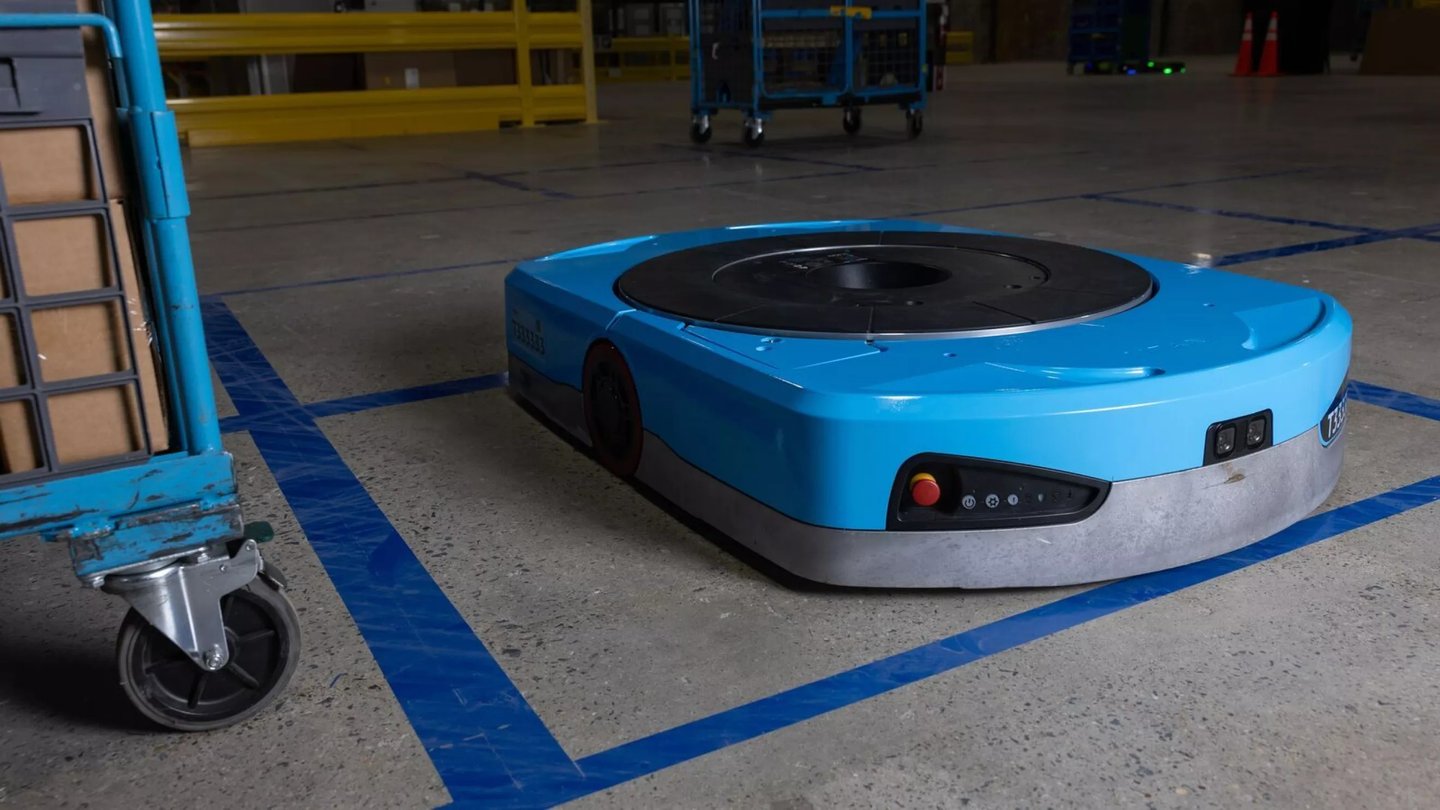Amazon deploys robot for heavy lifting in fulfillment center
The newest addition to Amazon’s rapidly expanding roster of supply chain robots can lift up to 2,500 pounds.
Amazon is rolling out a mobile robot called Titan at its SAT1 fulfillment center in San Antonio. Titan helps carry products across the center and can lift up to two times more weight than Hercules, a recently launched robot which assists picking operations (see more details below).
Titan’s first task will be to carry larger, bulkier items like small household appliances or pallets of pet food and gardening equipment. The technology integrates several technologies from previous Amazon mobile robots, including the battery and charging management solution from Hercules, and the computer vision, obstacle detection, and user control systems from its Xanthus mobile robot.
Titan also uses hardware components from Amazon’s Proteus robot (see more details below) to manage its operating system as it plans, executes, and interfaces with other technologies within the facility. Amazon manufactures robots like Titan at its innovation hub in Massachusetts.
“Our in-house development model creates jobs and helps us iterate, scale, and deploy new technologies faster,” Cosette Jarrett, Amazon senior writer, said in a corporate blog post.
Amazon focuses on next-gen fulfillment center robotics
Amazon has been actively developing new, leading-edge robotic solutions for use in its fulfillment centers. The e-tailer says it has over 750,000 robots working collaboratively with its employees, taking on highly repetitive tasks. Fulfillment center robot models include the following:
Digit
In September 2022, Amazon began testing Agility Robotics' bipendal robot, Digit, at its robotics research and development site south of Seattle. These are mobile robots which are built in a human-like shape and can move like a person while also grasping and handling items with robotic "arms" resembling a human.
The initial use for Digit will be to help employees with tote recycling, the repetitive process of picking up and moving empty totes once inventory has been completely picked out of them.
Sequoia
Sequoia allows Amazon to identify and store inventory at fulfillment centers up to 75% faster than it could previously. When orders are placed, Sequoia also reduces the time it takes to process an order through a fulfillment center by up to 25%, improving shipping predictability and increasing the number of goods Amazon can offer for same-day or next-day shipping.
Building off a series of research and development efforts, Sequoia integrates multiple robot systems to containerize Amazon’s inventory into totes, bringing together mobile robots, gantry systems, robotic arms and a new ergonomic employee workstation.
The system works by having mobile robots transport containerized inventory directly to a gantry, a tall frame with a platform supporting equipment that can either restock totes or send them to an employee to pick out inventory that customers have ordered.
These totes come to employees at a newly-designed ergonomic workstation that allows them to do all their work between mid-thigh and mid-chest height. With this system, employees will no longer have to regularly reach above their heads or squat down to pick customer orders, supporting Amazon efforts to reduce the risk of injuries.
Hercules
The proprietary Amazon robot model called Hercules helps warehouse employees by traveling around facilities to retrieve shelves of products and delivering them to employees, who then pick the items customers ordered for shipping.
Hercules can lift up to 1,250 pounds and travel across the 1 million square feet of Amazon’s largest fulfillment centers.
Sparrow
In November 2022, Amzazon rolled out “Sparrow,” a new intelligent robotic system that can detect, select, and handle individual products in its inventory. Leveraging computer vision and artificial intelligence (AI), Sparrow can recognize and handle millions of unique items for picking, stowing and packing before they are shipped – at scale.
Proteus
In June 2022, the company announced Proteus,” its first fully autonomous mobile robot. Proteus moves autonomously through Amazon’s fulfillment and sort facilities using advanced safety, perception, and navigation technology developed by Amazon. Amazon is initially deploying Proteus in outbound handling areas for GoCarts (manual wheeled package transports) in its fulfillment centers and sort centers.
Cardinal
In June, Amazon also introduced Cardinal, a robotic lifting arm that uses AI and computer vision to efficiently select one package out of a pile of packages, lift it, read the label and precisely place it in a GoCart.
Leveraging Cardinal, Amazon says it can sort packages earlier in the shipping process with reduced risk of employee injury, resulting in faster process time in the facility. The company says shipping operations also run more smoothly because Cardinal converts batch-based manual work into continuous, automated work.
AR ID
Based on feedback from employees, the company created Amazon Robotics Identification (AR ID), an AI-based scanning capability with computer vision and ML technology to enable easier scanning of packages in supply chain facilities.
AR ID removes the manual scanning process by using a camera system that runs at 120 frames per second and is designed to let employees can handle packages freely with both hands.
Containerized storage
Amazon’s Containerized Storage System determines which pod has the container with the needed product, where that container is located in the pod, how to grab and pull the container to the employee, and how to pick it up once the employee has retrieved the product.


